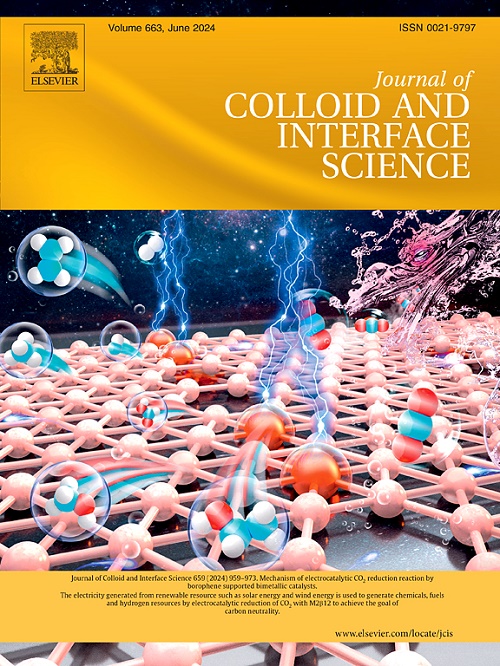独立双金属Co/Ni-MOF泡沫在非热等离子体催化下增强甲烷干重整。
IF 9.7
1区 化学
Q1 CHEMISTRY, PHYSICAL
引用次数: 0
摘要
了解活性金属有机框架(MOFs)的结构和界面优劣对于构建非热等离子体辅助转化温室气体的高效催化剂至关重要。在此,我们提出了一种支撑在细菌纤维素(BC)泡沫上的独立双金属(Co/Ni)MOFs(Co/Ni-MOF@BC),用于同轴介质阻挡放电(DBD)等离子催化系统、其中,Co/Ni 离子配位对具有丰富微米级孔隙的延展性 BC 纳米纤维网络产生了引人入胜的质地提升作用,在更强的等离子体催化相互作用下,可将占主导地位的丝状微放电电流提高到 180 mA。值得注意的是,与单金属 MOF@BC 泡沫相比,这种双金属 Co/Ni-MOF@BC 的碱性吸收能力也得到了大幅提高,二氧化碳温度编程解吸(TPD)结果进一步证实了这一点。得益于其 3D 优越性和 Co/Ni 双调控的协同作用,Co/Ni-MOF@BC 的 CO2 和 CH4 转化率最高,分别达到 52.31 % 和 71.50 %,是单金属同类产品和 Co/Ni-MOF 粉末的 1.5 倍和 1.3 倍以上。此外,该催化剂长期的 DRM 性能优异,结晶度、形貌和表面化学状态均保持不变,这也证明了其强劲的循环性能。在设计独特的 DRM 催化剂时,我们同时考虑了催化剂的存在形式和 MOFs 的界面优化,相信这种独立的三维 Co/Ni-MOF@BC 泡沫能激发更多的研究成果,设计出具有丰富孔隙和碱性吸收位点的功能催化剂,从而加速 CO2/CH4 转化的氧化还原动力学。本文章由计算机程序翻译,如有差异,请以英文原文为准。

Free-standing bimetallic Co/Ni-MOF foams toward enhanced methane dry reforming under non-thermal plasma catalysis
Understanding of the structure and interfacial merits that reactive metal–organic frameworks (MOFs) undergo is critical for constructing efficient catalysts for non-thermal plasma-assisted conversion of greenhouse gases. Herein, we proposed a free-standing bimetallic (Co/Ni) MOFs supported on bacterial cellulose (BC) foams (Co/Ni-MOF@BC) toward the coaxial dielectric barrier discharge (DBD) plasma-catalytic system, of which the Co/Ni ions coordination demonstrated an intriguing textual uplifting of the malleable BC nanofiber network with abundant pores up to micrometer-scale, which could impart a more intensive predominant filamentary microdischarge current to 180 mA with stronger plasma-catalytic interaction. Remarkably, compared to the monometallic MOF@BC foams, this bimetallic Co/Ni-MOF@BC also delivered a substantially improved alkaline absorption ability as further confirmed by the CO2- temperature-programmed desorption (TPD) result. Benefiting from its 3D superiority and synergy of Co/Ni dual-regulation, the Co/Ni-MOF@BC, therefore, displayed the highest CO2 and CH4 conversion rates to 52.31 % and 71.50 %, which was above 1.5 and 1.3 times higher than those of monometallic counterparts and Co/Ni-MOF powder. Additionally, its robust cycling performance has also been evidenced by the excellent long-time DRM performance, unchanged crystallinity, morphology, and surface chemical states. By taking both the catalyst existing form and interfacial optimization of MOFs into consideration for designing a unique DRM catalyst, we believed this free-standing 3D Co/Ni-MOF@BC foams could inspire more research outputs on the design of functional catalysts with abundant pores and alkaline absorption sites to accelerate the redox kinetics of CO2/CH4 conversion.
求助全文
通过发布文献求助,成功后即可免费获取论文全文。
去求助
来源期刊
CiteScore
16.10
自引率
7.10%
发文量
2568
审稿时长
2 months
期刊介绍:
The Journal of Colloid and Interface Science publishes original research findings on the fundamental principles of colloid and interface science, as well as innovative applications in various fields. The criteria for publication include impact, quality, novelty, and originality.
Emphasis:
The journal emphasizes fundamental scientific innovation within the following categories:
A.Colloidal Materials and Nanomaterials
B.Soft Colloidal and Self-Assembly Systems
C.Adsorption, Catalysis, and Electrochemistry
D.Interfacial Processes, Capillarity, and Wetting
E.Biomaterials and Nanomedicine
F.Energy Conversion and Storage, and Environmental Technologies

 求助内容:
求助内容: 应助结果提醒方式:
应助结果提醒方式:


